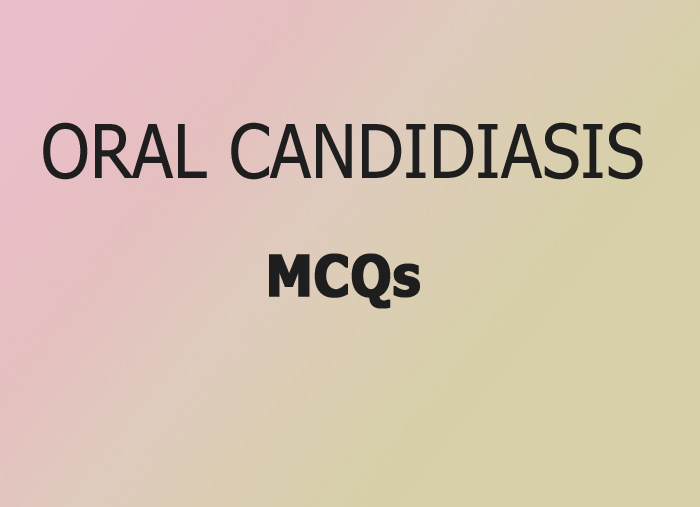- NEED HELP? CALL US NOW
- +919995411505
- [email protected]

1. Oral thrush develops in infants at______?
A. 3days
B. 2-6 weeks
C. 10-12 weeks
D. 18 mouths
Answer:B
Oral thrush in infants
– 6th and 10th day after birth
– Infection from maternal vaginal canal
– Soft white/bluish whit, adherent patches on oral mucos
– Painless
– Removed with little difficulty
2. Thrush______?
A. Occurs only in elderly
B. Is caused by a gram -ve bacteria
C. Is seen clinically as a proliferative lesion
D. Responds to nystatin
Answer:D
Thrush
• Caused by Candida albician
• Superficial infection of upper layer of oral mucous membrane
• Fungal growth – desquamation of epithelial cell and accumaltion of bacteria, keratin and necrotic tissue forming pseudomembrane
• Affect both infants and adults
3. Denture sore mouth is cased by______?
A. Actinomyces
B. candida albicans
C. Blastomyces
D. None of the above
Answer:B
Denture stomatitis
• Bright red palatal tissue – edematous and granular
• Sharply outline of redness
• Multiple pinpoint foci of hyperemia usually involving the maxilla
4. Candid infection is not seen in_____?
A. Median rhomboid glossitis
B. Geographic tongue
C. Oral thrush
D. Denture stomatitis
Answer: B
5. Oral candidiasis is divided into primary and_____?
A. Secondary infections
B. Subsidiary infections
C. Subclinical infections
D. All of the above
Answer:A
Classification of candidiasis
Primary Oral Candidiasis
• ACUTE
• Pseudomembranous
• Erythematous
• CHRONIC
• Hyperblastic
• Erythematous
• Pseudomembranous
• CANDIDA ASSOCIATED LESSION
• Denture stomatitis
• Angular stomatitis
• Median rhomboid glositis
• Keratinized primary lesion super infected with candida
• Leukaplakia
• Lichen planus
• Lupus erythematous
Secondary candidiasis
• Manifestation of Systematic mucocutaneous candidiasis – thymic aplasia and candida endocrinopathy syndrome
6. Which type of candidiasis is associated with leukoplakia is______?
A. Acute pseudomembranous candidiasis
B. Acute atrohpic candidiasis
C. Chronic atrophic candidiasis
D. Chronic hyperplastic candidiasis
Answer:D
CHRONIC HYPERPLASTIC CANDIDIASIS
• Candidal leukoplakia
• Persist without any pain for years
• Doesn’t rubs off with lateral pressure
• Slightly white to dense white with cracks and fissures occasionally
• Vague border – epithelial dysplasia
7. Candida infection is involved in______?
A. migrating geographic tongue
B. median rhomboidal glossitis
C. Prolonged tetracycline therapy
D. All of the above
Answer:B
8. Clinical diagnosis of candidiasis is confirmed by_____?
A. Characteristic odour
B. Demonstration of mycelia and spores in scrapping
C. Response to injection of vitamin B12
D. Demonstration of ray fungus in granules
Answer:B
9. Thrush refers to_____?
A. Acute atrophic candidiasis
B. Acute pseudomembranous candidiasis
C. chronic atrophic candidiasis
D. chronic hyperplastic candidiasis
Answer:B
10. ID reaction is associated with______?
A. apthous ulcer
B. herpetic stomatitis
C. syphilis
D. candidiasis
Answer:D
ID REACTION
• Secondary response characterized by localized or generalized sterile vesicopapular rash that is believed to be allergic response – candida antigen (monoloids)




